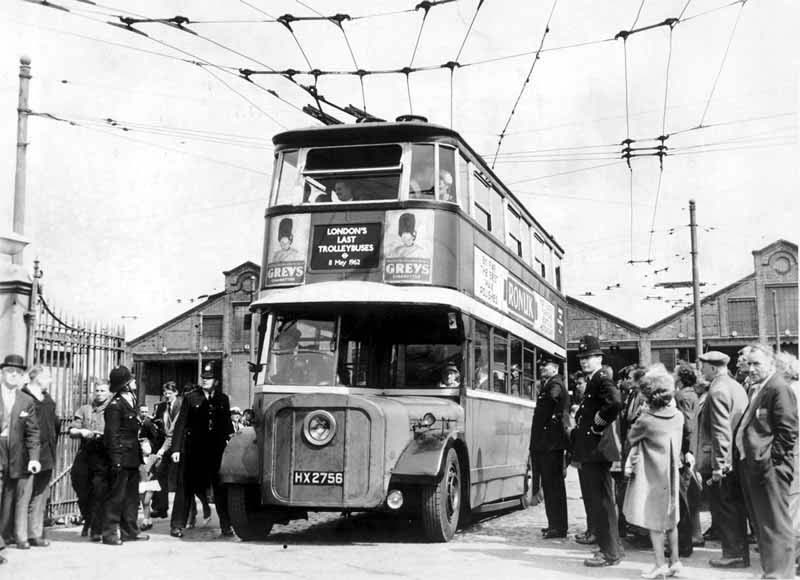
Click on picture [HX2756] for an enlarged version
Memories of London Trolleybuses around Fulwell
 |
Click on picture [HX2756] for an enlarged version |
From: "Nick Stanbury" <nickstanbury@freenet.co.uk>
I've just discovered your page on the Diddler No 1 - well done and thanks for stirring up so many
fond memories!
For the record, I lived close to Fulwell Depot [as I still think of it] from 1949 to 1973 and well remember the last
day of trolleybuses, being [at 13] allowed a 'late pass' to watch the procession from Hampton Hill to the Depot; indeed,
I managed a short ride on the last bus itself. Unfortunately, school prevented me from seeing the afternoon's events
with the Diddler etc., but the various photos and film available are some compensation.
You say that No 1 ran at Carlton Colville in 2000 but is now in poor condition. It would be nice to think it could be
seen in operation again [e.g. at Carlton].
A small query - you refer to the Diddlers being replaced by the 'Q' class. I'm no expert but am well aware of the 'Q1'
class which were the mainstay of Fulwell services [from, I think, 1948] until they were sold out of service; was there
a 'Q' also? I have two of the splendid OOC models of the 'Q1' in LT livery but have also seen a version in Glasgow
livery - I know that a number went to Spain but did any Q1s go to Glasgow or elsewhere?
Your picture 344 reminds me of the antics of local schoolboys [not me, of course] who would hide in the bushes by the
stop on the Twickenham side of the 'Nelson' and surreptitiously change the overhead points [sprung to lie normally for
the 667 route towards Fulwell] when a 667 came by. The result was a dewire by the 'Nelson' when the bus went straight
on and the trolley poles tried to take the 601 route into Stanley Road. Out came the bamboo pole and off into the
distance went the boys!
I must now look at your other pages - maybe you deal there with some of the issues above.
From: "Elizabeth Cheyne" <elizabeth.cheyne@virgin.net>
Can you tell me where the term Diddler comes from please? I was in the London Transport Museum yesterday and I saw this word mentioned quite a lot in the videos and books available but I don't know what it means. Who coined it, and why?
From: "Gordon Mackley" <electric_traction@hotmail.com>
There is no agreement on this one. It has been suggested by the proponents of other modes that
seeing wires you expected a tram and were diddled when you got a trolleybus or alternatively looking a bit like an
LT type motor bus, you were diddled because it wasn't a motor bus. As the LUT trolleybuses were much more popular
with the travelling public than both the trams they replaced and motor buses, both stories seem extremely unlikely
and were I think invented long after the term was in use [which was very soon after introduction].
The only plausible story I have heard is that the drivers coined the title because unlike with their former tram
vehicles they were now able to 'diddle' in and out of the other traffic. This would of course fit in well with its
very early use as a term.
From: "Chris Hebbron" <cehebbr@timewarpuk.net>
Commercial vehicles today have air-pressure brakes. After braking, a compressor restores the air
in the tanks to the original pressure. Many commercial vehicles in the 30's and 40's had the very reverse;
vacuum-assisted brakes! Once these vehicles had stopped, the pump [reverse compressor] sucked the air out of the tank
to restore the vacuum. So the pumps made a sort of muffled knocking, which, on these trolleybuses, was described by
some passengers as 'diddling'.
Underground trains, at least up to the 1938 vintage, also 'diddled' when waiting in stations, after using their brakes
in stopping. I can recall the noise on both types of transport. I regularly got the 604/605 trolleybuses from Raynes
Park to Kingston or Hampton Court.
Since it is much harder to maintain a full vacuum when there's a leak than full pressure when there's a leak, vacuum
brakes became obsolete. I don't think that they were so efficient, either, even when working well.
From: "GEOFF HOLLAND" <jgholland@totease.eclipse.co.uk>
I lived at the time of the last trolleybus to Fulwell Depot 1521 in New Malden where I saw the poles cross over the wires for
the last time ever a very sad day for all as the bus service was very poor and the public were not happy with it.
At Charlton Collville I met up again with 1521 still in good form and sat inside it for a few minutes. But 1521 was not a 604 route trolleybus it was
a make do bus till the end. We had the Q1s, 1766 was the first I saw replacing the diddlers and diddler no 7 was the first trolleybus I ever rode in,
mixed with the trams on route 4 and tram 71. LCC cars were still using the route Wimbledon to Hampton Court till around 1933.
Anyway all the best, Geoff Holland now living in Cornwall.